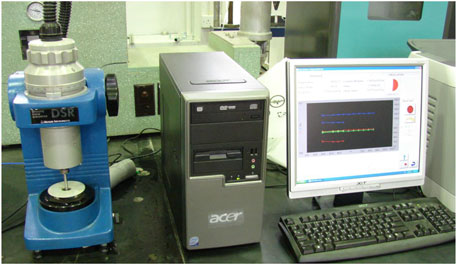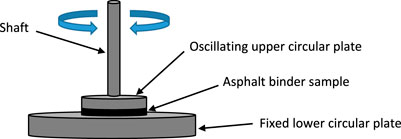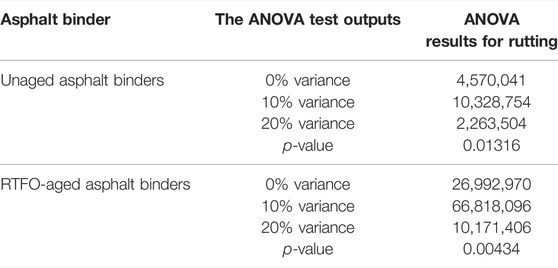- 1Department of Civil and Environmental Engineering, University of Sharjah, Sharjah, United Arab Emirates
- 2Jordan University of Science and Technology, Irbid, Jordan
- 3Civil Engineering Department, Ajman University, Ajman, United Arab Emirates
- 4Civil Engineering Department, Jordan University of Science and Technology, Irbid, Jordan
Asphalt pavements are subjected to major distresses like fatigue, rutting, and low-temperature cracking due to repeated traffic loading and climatic conditions. The modification of the asphalt binder (a major component of an asphalt paving mixture) using additives helps in minimizing the possibility of pavement distresses. The cement additive was used in this study at cement-to-asphalt (C/A) percentages of 0, 10, and 20% by volume. The main objective of the study was to investigate the impact of C/A percentage, temperature, and loading frequency on the rutting resistance of asphalt binders using statistical analysis. Two aging conditions were also used: unaged condition and short-term aging condition in the rolling thin-film oven (RTFO). The dynamic shear rheometer (DSR) test was used to characterize the asphalt binders at ten loading frequencies (0.1, 0.3, 0.6, 1, 1.59, 3, 5, 7, 8, and 10 Hz) and four temperatures (58, 64, 70, and 76°C). These combinations were used to cover a wide range of combined conditions and to follow the high-temperature range for the Superpave performance grade (PG) system. Multiple statistical analyses [the one-way analysis of variance (ANOVA) and correlation tests] were performed to identify the relation between the tested variables and the rutting parameter (G*/sinδ). Findings of the study have shown that the loading frequency has a significant effect on the rutting parameter for unaged and RTFO-aged asphalt binders under different temperatures and using different C/A percentages. Regression analysis was conducted to depict an accurate model that can predict the rutting parameter (G*/sinδ) for each aging condition. Based on the regression analysis, nonlinear power models were developed for the rutting parameter of four groups: unaged unmodified, unaged cement-modified, RTFO-aged unmodified, and RTFO-aged cement-modified asphalt binders with the coefficient of determination (R2) values of 0.986, 0.986, 0.996, and 0.992, respectively. The ANOVA test results showed that the cement addition (represented by the C/A percentage) had a significant impact on the rutting parameter of cement-modified asphalt binders for both aging groups. Furthermore, the correlation tests conducted in this study showed that the temperature and loading frequency had significant effects in the predictive models of the rutting parameter of unmodified asphalt binders and that the temperature, loading frequency, and C/A percentage had significant effects in the predictive models of the cement-modified asphalt binders.
1 Introduction
Stresses develop inside the pavement structure as a result of repeated traffic loading and climatic conditions. Therefore, the utilized mixtures need to sustain several distress stimuli throughout their service life (Qiao et al., 2013). Thus, the enhancement of pavement structures has become a major concern for researchers and engineers. Therefore, several modifications have been tested and applied on asphalt binders (the main component of the asphalt paving mixture) in order to mitigate pavement distresses. The loading time and temperature affect the behavior of asphalt binders due to the nature of this viscoelastic material (Somé et al., 2015). Fluid-like behavior is expected from these asphalt binders at high temperatures, while brittle-viscoelastic behaviors are found at low and intermediate temperatures (Batista et al., 2018). Thus, the asphalt pavement experiences a wide range of distresses due to the fluctuation in climatic conditions throughout its service life. Two of the most commonly observed types of distresses are thermal cracking and rutting. Thermal cracking is caused by the drop in temperature during cold seasons that increases the asphalt binder stiffness significantly (Behnood and Olek, 2017). However, rutting occurs at high pavement temperatures due to several factors including reduction in the stiffness of asphalt binder (Ameri et al., 2018). The need to strengthen asphalt pavements becomes necessary due to the distresses that occur in the pavement structure, the increase in traffic loadings, and the use of new axle configurations (Cong et al., 2015). Therefore, several techniques have been implemented to strengthen the asphalt pavement against those distresses. The strengthening techniques were mainly based on the modification of the asphalt binder to enhance the expected behavior of the conventional asphalt binders (Ibeagi et al., 2012; Saboo and Kumar, 2016; Behnood and Olek, 2017; Brasileiro et al., 2019). The major benefit of the modification of the asphalt binder is increasing the complex modulus value at high service temperatures and decreasing it at low and intermediate service temperatures.
One of the main modifications was made to the cement asphalt concrete mix, to help withstand the variation in temperatures without showing failure under the existing distresses. Multiple studies were conducted to assess the effect of filler additives (in general) on the performance of asphalt mixtures under high temperatures. One study tested the effect of changed filler materials in the mix on the mechanical performances through the resilient modulus, dynamic creep, and indirect tensile tests (Likitlersuang and Chompoorat, 2016). The results showed that modifying the properties of the mix had improved the strength, stiffness, and stripping resistance significantly. Moreover, fly ash, when added to cement asphalt mixes, enhanced high-temperature rutting resistance. Moreover, as the field of research is expanding to improve the expected performance of the proposed cement-modified asphalt mixes, the issue of having more than one factor at once causing the distresses needs to be investigated properly. Taherkhani et al. (2017) assessed the performance of modified asphalt concrete against a variety of temperatures and loading frequency in terms of resilient modulus. A dynamic creep test was performed in the study at different temperatures (−5°C, 5°C, 20°C, and 40°C) and loading frequencies of 0.5, 1, 5, and 10 Hz. The results showed that the resilient modulus increased with the increase in temperature and loading frequency in both dry and saturated conditions. Moreover, a study by Al-Khateeb and Ghuzlan (2014) was carried out to evaluate the complex effect of temperature, loading frequency, and stress level on the fatigue life of asphalt paving mixtures. The results showed that the fatigue life increased with the increase of loading frequency at the same temperature, and decreased with the increase in temperature from 20°C to 30°C.
Al-Khateeb and Al-Akhras (2011) investigated the properties of Portland cement–modified asphalt binders using the Superpave rotational viscosity (RV) test and the dynamic shear rheometer (DSR) test. The study tested cement-modified asphalt binders at six cement-to-asphalt (C/A) ratios by volume plus the PG64 control asphalt binder (C/A = 0.00) at a variety of test temperatures and loading frequencies/rotational speeds. The results showed that increasing the C/A ratio increased the RV of the tested asphalt. Moreover, the increase in the C/A ratio increased the stiffness of asphalt binders represented by the complex shear modulus (G*) value that enhanced the rutting parameter represented by the G*/sinδ value.
Mannan et al. (2015) used the beam fatigue tests to examine the fatigue behavior of RAP asphalt mixtures at different loading frequencies and strain levels. It was found that fatigue levels increased with the increase in loading frequency, while fatigue levels decreased with the increase in strain level.
Yildizel et al. (2020) investigated the mechanical and durability properties of roller-compacted concrete (RCC) for pavement containing ground calcium carbonate (GCC). The cement was replaced by GCC at five different percentages by weight 5%, 10%, 15%, 20%, and 25%. The durability characteristics, sulfate and freeze–thaw resistances, and compressive and flexural strengths up to 90 days of the RCC mixtures were evaluated. The findings of their study showed that the GCC addition of up to 15% increased the mechanical strength values and enhanced the durability characteristics of the RCC mixtures. Scanning electron microscopy was also conducted, and the results revealed that GCC exhibited an improvement in the durability properties of the specimens.
Bhat and Mir (2021) investigated the rheological properties of adding different percentages of nanosilica to the asphalt binder. The effect of temperature, strain rate, and frequency was evaluated. Different tests were used, namely, temperature sweeps, the Superpave rutting parameter, the multiple stress creep and recovery test, creep tests, and zero shear viscosity. It was found that rutting potential is enhanced by adding nanosilica. In addition, fatigue performance and aging resistance were improved by adding nanosilica.
Kumar et al. (2021) characterized the properties of the modified asphalt binder with ethylene–propylene–diene–monomer (EPDM) rubber waste from the automobile industry. Four waste EPDM rubber contents were used (2%, 4%, 6%, and 8% by binder weight). Different tests were used such as storage stability, penetration, softening point, temperature and frequency sweeps, master curve, multiple stress creep recovery, and Burger’s model fit. Furthermore, Hamburg wheel tracking, indirect tensile strength, and stiffness modulus tests were used for performance characterization. Results of this study revealed that rutting and fatigue performance were enhanced by adding EPDM to the asphalt binder. Furthermore, tensile strength and stiffness were improved compared to the control mixes.
Singh et al. (2020) performed frequency sweep tests with frequency (ω) = 100–0.01 rad/s on SBS-modified binders and found the rheological properties overlap at ω ≥ 1 rad/s, while the property erosion was obvious at ω ≤ 0.1 rad/s and test temperatures >50°C. Based on results from this study, the rheological parameter should be measured at ω ≤ 0.1 rad/s for good quality control.
Li and Yang (2020) examined the effect of loading frequency, temperature, and other factors on the adsorbed film thickness. Results of this study showed that with the decrease in loading frequency and the increase in temperature, the film thickness between asphalt binder and mineral filler became thicker which was related to stronger physicochemical interaction.
2 Significance of Work
Based on the previous studies of the literature, it is clear that CMA binders significantly enhance pavement resistance against common distresses, such as rutting. However, no previous studies have been conducted to assess the impact of loading frequency on the behavior of cement-modified asphalt binders. Therefore, the present study aims at evaluating the impact of changing the C/A percentage on the rheological properties of CMA binders at different temperatures and loading frequencies. Additionally, all investigations were carried out for both unaged (fresh) asphalt binders and asphalt binders aged for a short-term in the rolling thin-film oven (RTFO). The data were collected using experimental testing, namely, using the dynamic shear rheometer (DSR) test. Following this, statistical analysis was performed to assess the impact of each mentioned parameter on the rheological behavior of the CMA binders. The one-way analysis of variance (ANOVA) and correlation tests were used to depict the relationship between all parameters and the binder performance. Finally, a regression analysis was conducted to predict the rutting resistance parameter using the abovementioned parameters for both aged and unaged binders.
3 Methodology
The study approach has been divided into two major parts: laboratory work was presented by testing the different CMA binder samples using the dynamic shear rheometer (DSR) test and statistical analysis was presented by the ANOVA test, correlation test, and regression model development.
3.1 Laboratory Testing
3.1.1 Materials
The original (fresh) asphalt binder used in this study is a 60/70-penetration grade asphalt binder (PG 64–10 based on the Superpave Performance Grading System). The Portland cement material used in the study was obtained from a local source. The ordinary Portland cement is the type of cement used in this study. The properties of the asphalt binder and cement are shown in Table 1. The cement-to-asphalt (C/A) percentages used in the study are 0%, 10%, and 20% by volume of asphalt binder.
3.1.2 Sample Preparation
Cement-modified asphalt binders were prepared at three percentages: 0%, 10%, and 20% by volume. The 0% represents the control asphalt binder where no cement is added to the asphalt binder. The specific gravities of the asphalt binder and the cement material were obtained (1.01 and 3.12, respectively) to be used in estimating accurately the amount of cement to be added to the asphalt binder at each C/A percentage. A high-shear mixer was used to mix the cement with the asphalt binder at a high rotational speed of 2000 rpm for 15 min at a high temperature ranging between 160°C and 170°C.
3.1.3 Dynamic Shear Rheometer (DSR) Test and Samples
The dynamic shear rheometer (DSR) shown in Figure 1 was used to characterize the cement-modified asphalt (CMA) binders at high and intermediate temperatures for rutting and fatigue cracking resistance, respectively. The DSR samples were prepared by heating the cement-modified asphalt binder at each C/A percentage until it became fluid enough to be poured. The DSR mold of 1-mm thickness and 25-mm diameter was used to prepare the samples. Unaged CMA binders and rolling thin-film oven (RTFO)–aged CMA binders were tested at high temperatures of 58, 64, 70, and 76°C. DSR frequency sweep tests were conducted for all CMA binders at loading frequencies of 0.1, 0.3, 0.6, 1, 1.59, 3, 5, 7, 8, and 10 Hz. The DSR tests were performed following the standards of the Superior Performing Asphalt Pavements (Superpave) system. Figure 2 shows a schematic diagram of the DSR test.
The DSR test is carried out by applying shear force on the binder set between upper and lower oscillation plates, with an oscillation angle of 10 rad/s. The DSR test provides measurements of the complex shear modulus (G*) value and the phase angle (δ) of the asphalt binder. The complex modulus value represents the stiffness of the asphalt binder, while the phase angle represents the lag in the response of the asphalt binder (viscoelastic behavior). For instance, at 0°, 90°, and 0°–90° phase angles, the asphalt binder shows elastic, viscous, and viscoelastic behavior, respectively (Behnood and Olek, 2017; Al-Khateeb and Al-Akhras, 2011; Ghuzlan, Al-Khateeb, and Qasem, 2015). Moreover, the rutting parameter (G*/sinδ) and the fatigue parameter (G*sinδ) values were estimated from the G* and δ values to predict the performance of asphalt binders against rutting and fatigue cracking, respectively. The rutting parameter (G*/sinδ) value was computed from the G* and δ values obtained for the unaged and RTFO-aged asphalt binders at high temperatures since rutting typically initiates in the early stages of the pavement life (Singh and Girimath, 2018). Due to the fact that fatigue cracking is normally initiated at later stages of the pavement life, the DSR test was performed on asphalt binders aged long-term in the Pressure Aging Vessel (PAV) (Singh and Girimath, 2018).
To resist rutting in asphalt pavements, an asphalt binder with high stiffness and elastic behavior is needed. For this reason, in the criteria of the Superpave system, minimum requirements were set for the rutting parameter (G*/sinδ) values of 1.0 and 2.2 kPa for the unaged (fresh) and RTFO-aged asphalt binders, respectively. On the other hand, to resist fatigue cracking in asphalt pavements, an asphalt binder with low stiffness (soft) and high elastic parts is required. Therefore, the Superpave system specifies a maximum limit for the fatigue parameter (G*sinδ) value of 5,000 kPa for the PAV-aged asphalt binders.
3.2 Statistical Analysis
The present study included multiple statistical analyses in order to enhance the knowledge regarding the effect of varying the surrounding conditions such as temperature and loading frequency on different C/A percentage samples. The conducted statistical analyses were ANOVA and correlation tests. Furthermore, a regression model was established to come up with a model that can predict the rutting parameter depending on the C/A percentage used in the mix, temperature, and the expected loading frequency on the pavement. The obtained data set from the experimental testing included the following:
• 10 loading frequencies (0.1, 0.3, 0.6, 1, 1.59, 3, 5, 7, 8, and 10 Hz)
• 4 temperatures (58, 64, 70, and 76°C)
• 3 CMA binder percentages (0%, 10%, and 20%)
• 2 Aging levels; unaged (fresh) binders and short (RTFO)-aged binders
• Total of 240 DSR tests, 120 for each aging level
3.2.1 Analysis of Variance (ANOVA)
There are two major types of the ANOVA test: one-way ANOVA and two-way ANOVA. One-way ANOVA is a statistical test implemented to compare the variance in the means group with one independent variable. Therefore, one-way ANOVA gives two possible descriptions for the tested groups: null hypothesis in which there is no difference between the groups and equality between means or alternative hypothesis in which there is a difference. Conducting multiple t-tests by evaluating the tested groups together is the same as conducting the one-way ANOVA test. However, one-way ANOVA assumes that the tested sample follows a normal distribution behavior and variance obtained from the data in the different tested groups is the same. On the other hand, two-way ANOVA is a more advanced form of one-way ANOVA in which it tests the significance of two independent variables with the other dependent variables. Moreover, two-way ANOVA assumptions are the same as those of one-way ANOVA; however, it assumes that the tested independent variables should be in categorical independent groups.
In this study, to evaluate any significant differences between the three factors considered in the study (C/A percentage, temperature, and loading frequency), the one-way ANOVA statistical test was performed. The p-value is the main outcome of the one-way ANOVA test; it assesses the difference between the tested groups. In case the p-value is less than 0.05, a significant difference between the tested means is concluded and the null hypothesis is rejected. Whereas if the p-value is higher than 0.05, the null hypothesis is accepted and it means that the tested means are statistically not different.
3.2.2 Correlation Analysis
The study implemented the correlation test in order to determine if one of the testing factors had an effect on the outcome rutting parameter of the CMA binders. The correlation test could measure the strength of two numerically measured and continuous parameters. The indicator parameter is defined as the correlation coefficient and ranges between −1 and 1, depending on the strength of the relationship between the tested variables (Mathworks, 2017). The relation between the variables is considered positively correlated if the coefficient came up to more than zero and the strength of the relationship increases depending on how close the coefficient is to 1. However, the variables are considered negatively correlated if the coefficient was less than zero and the strength of the relation increased by getting close to −1. In case the correlation coefficient was equal to zero, the tested variables are set to be uncorrelated. There are several types of correlation tests, such as Pearson correlation, Kendall rank correlation, Spearman correlation, and the point-biserial correlation. However, the most commonly used correlation test is Pearson correlation which was implemented in the study. The Pearson coefficient r can be calculated using the following equation:
where r = Pearson product–moment correlation coefficient, x, y = set of the tested variables, and n = sample size.
3.2.3 Regression Analysis
There are several types of regression analyses depending on the complexity of the relation between the dependent variable and the independent variables and the number of independent variables affecting the dependent variable. The two main types of regression analyses are linear and nonlinear regression analyses. Nonlinear regression is used when the existing data are presented using a scatter plot, and the data show a form of a curvilinear line. The nonlinear regression analysis predicts the best possible function of independent variables to predict the dependent variable in the following form:
where Y = dependent variable; X1, 2, 3 = independent variables; and a, b, c, d = regression coefficients.
However, linear regression is implemented when the scatter plot shows a straight line between the dependent and independent variables. Therefore, the regression analysis is performed to check the multiple possibilities of nonlinear relations such as polynomial of higher than the 2nd order, exponential, or logarithmic relationships. The regression analysis gives an indication of the accuracy of the estimated relationship between the tested independent variables and dependent variables. R-squared (R2) is a statistical measure of the extent of explaining the variance of the dependent variable using the variance of the independent variables. The value of R2 normally ranges between 0 and 1 depending on the type of dependence and the strength of the relation between the dependent and independent variables. If the R2 value is equal to 1, the regression predictions perfectly fit the data.
The R2 parameter is the difference between the total sum of squares of errors around the mean (SST) and the sum of squares of errors around the regression line (SSR) normalized by dividing this difference by SST to yield the following equation:
where R2 = regression model fitting parameter, SSR = sum of squares of errors (residuals), SST = total sum of squares around the mean, Yi = actual dependent variable acquired from experimental work, Yp = predicted dependent variable obtained from the regression model, and Yavg = average value of the actual dependent variable acquired from the experimental study.
In this study, the tested dependent variable was set to be the rutting parameter and the independent variables were set to be the C/A percentage, temperature, and loading frequency. Therefore, scatter plots were utilized to check the type of relation between the dependent variables and independent variables in order to identify the best fitting shape of the model. In this test, the provided set of data is a total of 120 points for each aging criterion with a tested-to-checked ratio of 70/30.
4 Results and Discussion
The effect of the addition of cement to the asphalt binder on the rheological properties of asphalt binders is discussed in this part. The cement-modified asphalt binders at percentages of 0%, 10%, and 20% were evaluated using the DSR test at different temperatures and loading frequencies for the unaged and RTFO-aged conditions. Moreover, the strength of the relationship between changing the temperature and loading frequency was assessed using multiple statistical analysis methods such as the correlation test, the one-way ANOVA test, and the regression modeling test using SPSS software.
4.1 One-Way ANOVA Test
The one-way ANOVA test checked whether there were any significant differences between the 3 C/A percentages at once in both the unaged and RTFO-aged samples. The p-value was obtained from the one-way ANOVA test for all combinations as shown in Table 2 which summarizes the one-way ANOVA test results. The results in Table 2 showed that the addition of cement to asphalt binders represented by the C/A percentages will affect the performance of the unaged and RTFO-aged asphalt binders with p-values of 0.01316 and 0.00434, respectively. Therefore, as the change of the C/A percentage has shown a significant difference in the performance of the tested samples of asphalt binders, the data set is concluded to pass the test and the null hypothesis is rejected, which means the assumption that the data came from the same group is not valid. However, the ANOVA test does not provide the actual magnitude of the significant effect of the C/A percentage on the rutting parameter. Thus, the correlation analysis was conducted.
4.2 Correlation Analysis
In this study, the correlation test was conducted on the unaged as well as RTFO-aged cement-modified asphalt using different C/A percentages under different loading frequencies for each of the tested temperatures. The effect of adding cement to asphalt binders on the performance of CMA binders was investigated under different loading frequencies (0.1, 0.3, 0.6, 1, 1.59, 3, 5, 7, 8, and 10 Hz) and at the temperatures of 58, 64, 70, and 76°C using the DSR test. The shear complex modulus (G*) and phase angle (δ) values after short-term aging for each asphalt binder were used for pavement performance prediction against rutting distress. Figure 3 shows the shear complex modulus (G*) and phase angle (δ) values for the RTFO-aged 10% cement-modified asphalt binder at 64°C using a histogram. Table 3 summarizes the coefficient of determination values describing the effect of changing loading frequencies throughout the four tested temperatures:
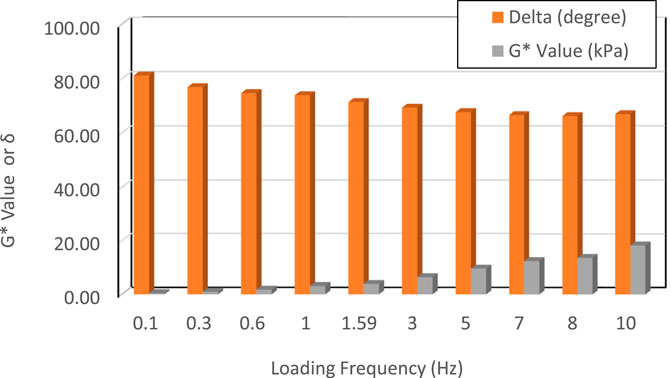
FIGURE 3. A histogram for shear complex modulus (G*) and phase angle (δ) values versus loading frequency (sample: RTFO-aged 10% cement-modified asphalt binder at 64°C).

TABLE 3. Correlation test results between the temperature and C/A percentage variables for the unaged and RTFO-aged CMA binders.
The correlation results show a minimum value of the Pearson R coefficient of 0.974 for the unaged CMA using a 10% C/A percentage under 76oC. Hence, the Pearson R coefficient ranges between 0.994 to 1.000 and 0.974 to 0.999 for the unaged and RTFO-aged CMA; the correlation is considered almost perfect which indicates that changing the temperature has a significant impact on the performance of the rutting parameter in which all the results tend to approach one, that is, very strong (almost perfect) correlation.
4.3 Regression Analysis
As per the previously conducted statistical analysis which had shown that changing the C/A percentage and loading frequencies have a significant effect on the rutting parameter and the data are correlated, the regression model analysis was conducted to develop an accurate model that can predict the rutting parameter. The regression analysis was conducted using binder-based hypotheses.
4.3.1 The Binder-Based Regression Model
This testing hypothesis was conducted on two main criteria based on modification and aging criteria which provided a total number of 40 points for each unmodified group and 80 points for each modified group. As the tested C/A percentages are 0%, 10%, and 20%, the unaged and RTFO-aged CMA points were divided into 40 unmodified CMAs (0% C/A percentage) and 80 points for the modified CMAs (10% and 20% C/A percentages). The temperature and C/A variables were tested separately with the rutting parameter to account for the behavior of the existing relation between each variable with the rutting parameter. Scatter plots have been implemented to investigate the relationship between each variable against the rutting parameter for each aging group. As shown in Table 4, the model gave a high adjusted R2 with a minimal value for the standardized error of the estimate in both unaged and RTFO-aged. Therefore, the utilized nonlinear regression is assumed to be able to predict the expected rutting parameter accurately.
Here, Y is the rutting parameter, C/A is the CMA binder percentage (%), T is the tested temperature (°C), and F is the loading frequency (Hz). Since the models in Table 4 represent the predictive models for four groups of asphalt binders at different temperatures, loading frequencies, and C/A percentages, it is difficult to show all the relationships in the figures in this part of the study. However, Figures 4, 5 show two examples of the relationship between the loading frequency and the rutting parameter (G*/sinδ) value for the unaged unmodified asphalt binder at 58°C and the unaged 20% cement-modified asphalt binder at 64°C, respectively. In these two figures, the measured and predicted values of the rutting parameter are presented in two curves as well to show the difference between the measured values and the values predicted from the developed models.
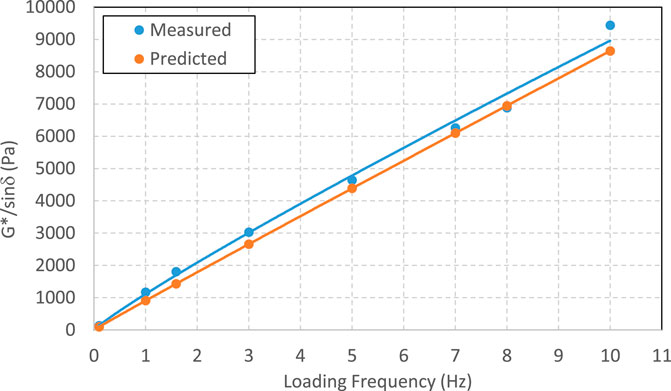
FIGURE 4. Measured and predicted G*/sinδ value versus loading frequency for the unaged unmodified asphalt binder at 58°C.
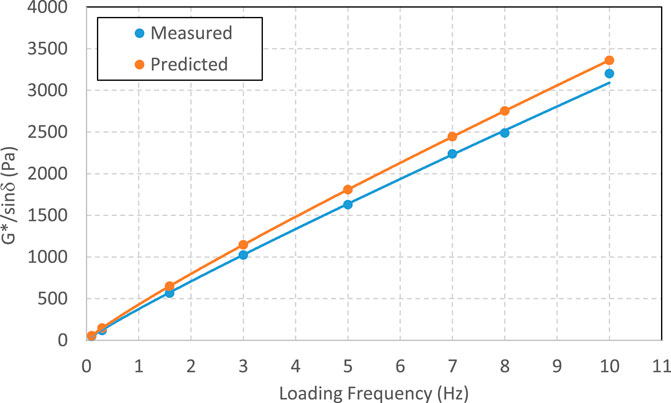
FIGURE 5. Measured and predicted G*/sinδ value versus loading frequency for the unaged 20% cement-modified asphalt binder at 64°C.
Figures 6–13 illustrate the relationship between the experimental (measured) values and the calculated (predicted) values for the rutting parameter (G*/sinδ) of the four groups of asphalt binders (unaged unmodified, unaged cement-modified, RTFO-aged unmodified, and RTFO-aged cement-modified asphalt binders). Each group has two figures, one for the modeling points and the other for the validation points.
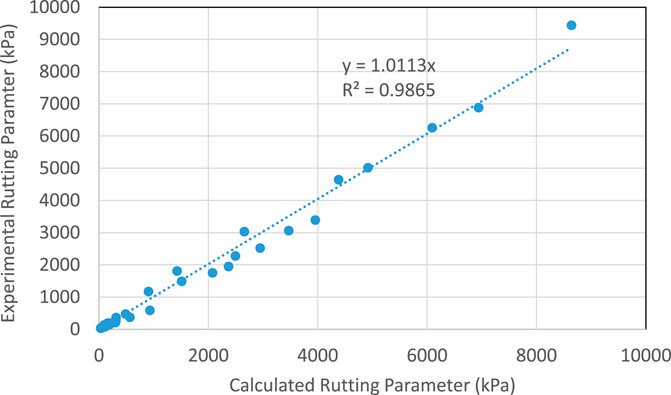
FIGURE 6. Predicted vs. experimental rutting parameter for the unaged unmodified CMAs: Modeling points.
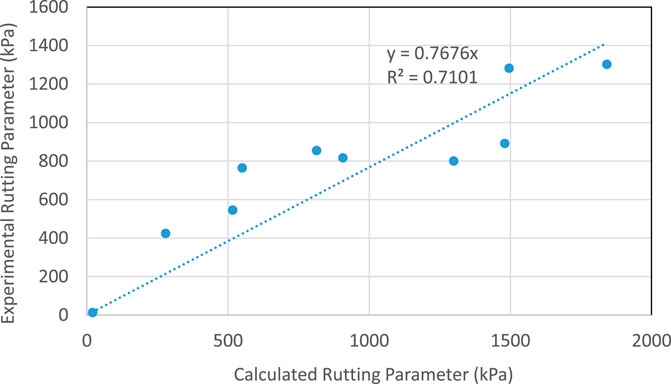
FIGURE 7. Predicted vs. experimental rutting parameter for the unaged unmodified CMAs: Testing (validation) points.
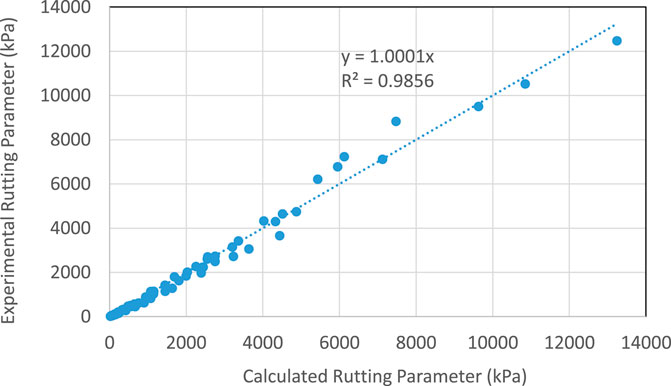
FIGURE 8. Predicted vs. experimental rutting parameter for the unaged modified CMAs: Modeling points.
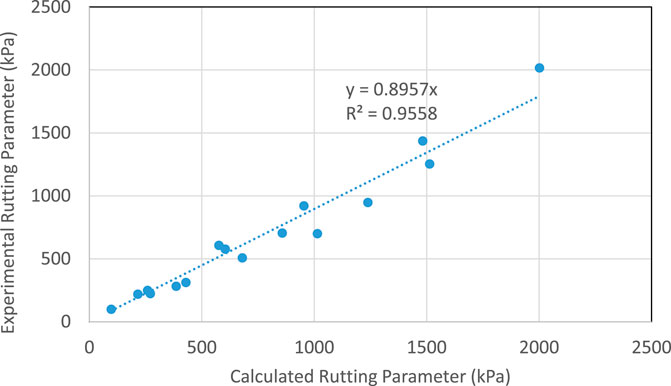
FIGURE 9. Predicted vs. experimental rutting parameter for the unaged modified CMAs: Testing (validation) points.
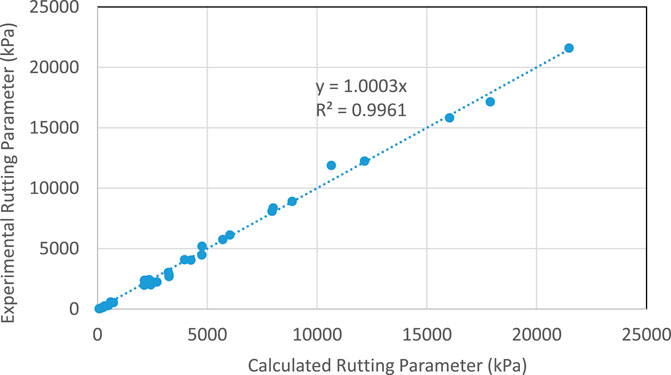
FIGURE 10. Predicted vs. experimental rutting parameter for the aged unmodified CMAs: Modeling points.
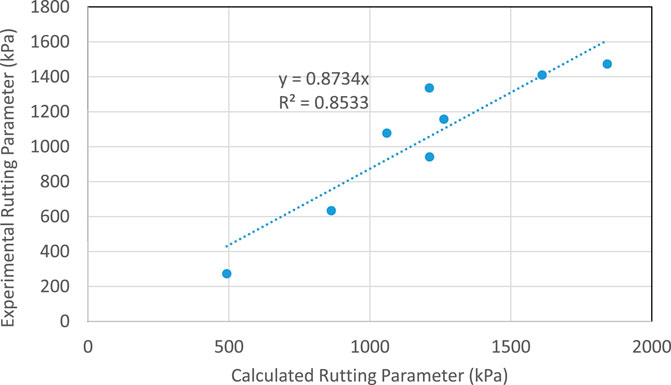
FIGURE 11. Predicted vs. experimental rutting parameter for the aged unmodified CMAs: Testing (validation) points.
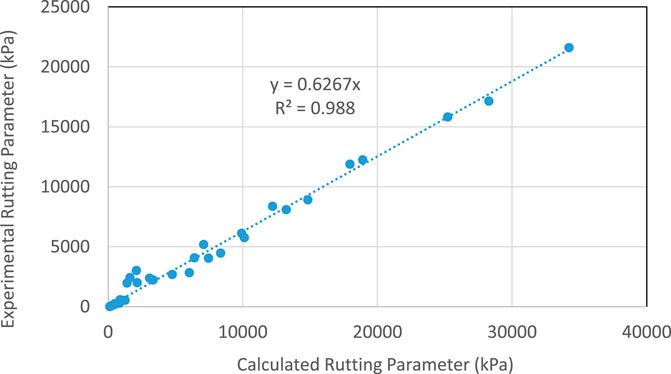
FIGURE 12. Predicted vs. experimental rutting parameter for the aged modified CMAs: Modeling points.
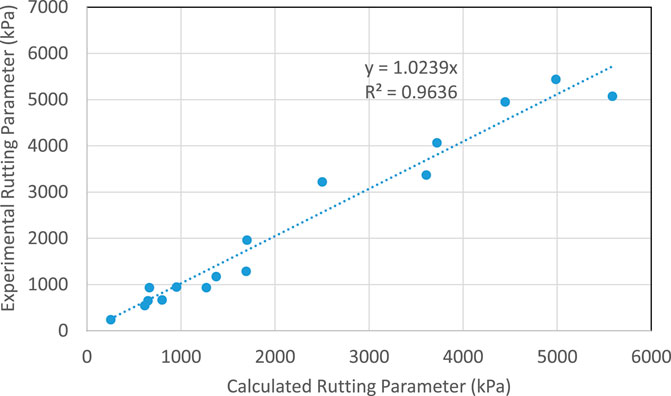
FIGURE 13. Predicted vs. experimental rutting parameter for the aged modified CMAs: Testing (Validation) points.
The comparisons have shown an accurate prediction of the acquired model from SPSS with slight variation in the estimated rutting parameter in the 10 and 16 testing points for both unaged and RTFO-aged CMAs, respectively. However, some consistent variation existed for rutting parameters at loading frequencies between 7 and 10 Hz. Therefore, those points were excluded from the regression analysis. It is worth mentioning that rutting distress becomes more pronounced on asphalt pavements at high temperatures and low loading frequencies (low truck speeds).
5 Conclusion
The study aimed at evaluating the effect of C/A percentage, temperature, and loading frequencies on unaged and RTFO-aged CMAs using the DSR test which assessed the rutting parameter under combined conditions. Moreover, multiple statistical analyses were conducted to evaluate the relation between the rutting parameter and the tested variables using the one-way ANOVA and correlation test in order to come up with a regression model using SPSS to predict the rutting parameter. Based on the analysis and results of this study, the following main findings and conclusions are drawn:
1) The one-way ANOVA test performed in the analysis of this study showed that there is a significant difference between the tested unaged and RTFO-aged CMAs by the DSR test with regard to the C/A percentage.
2) Conducting the correlation test has shown that changing the loading frequencies affects the rutting parameter significantly under different temperatures and C/A percentages. The Pearson R coefficient of the tested samples ranged between 0.994 to 1.000 and 0.974 to 0.999 for the unaged and RTFO-aged asphalt binders, respectively.
3) Scatter plots were tested to identify the type of the relationship between each variable and the rutting parameter (G*/sinδ). As a result of the nonlinear behavior of the three variables with the rutting parameter, multiple nonlinear forms have been tested in order to get the most accurate form that would contribute to forming a model for both the unaged and RTFO-aged cement-modified asphalt binders (CMAs).
4) A regression analysis has been conducted using SPSS in order to build a model for each group based on aging and modification conditions that can predict the rutting parameter precisely. The collected data from experiments have been grouped according to the modification condition and aging criteria in order to accommodate the need to predict the rutting parameter in a variety of conditions. Therefore, the nonlinear regression analysis has been conducted on 4 groups, namely, unaged modified and unmodified, and RTFO-aged modified and unmodified CMAs.
5) The model with the highest R2 and least sum of squares of error ratios has been chosen and checked on the testing points. So, each group was analyzed using SPSS, and a regression model was tested and provided an adjusted R2 prediction of the outcome models of 0.986, 0.986, 0.996, and 0.992 for the unaged unmodified and modified asphalt binders and the RTFO-aged unmodified and modified asphalt binders, respectively. As shown from the comparison, the model showed an acceptable prediction for the rutting parameter compared with the experimental data acquired from the lab.
In addition to the main findings of this study, it is also recommended to conduct further research in the future related to field data to fully investigate the impact of temperature, loading frequency, and the C/A percentage on pavement performance against rutting distress in the field.
Data Availability Statement
The data used to support the findings of this study are included within the article. Any additional data related to the article may be requested from the corresponding author.
Author Contributions
GA-K: Paper writing, data reduction, analysis of results, and experimental testing. KG: Paper writing, data reduction, and analysis of results. MI: Paper writing, data reduction, and analysis of results. AS: Paper writing, data reduction, and analysis of results. MN: Data reduction and analysis of results. YE: Data reduction and analysis of results.
Conflict of Interest
The authors declare that the research was conducted in the absence of any commercial or financial relationships that could be construed as a potential conflict of interest.
Publisher’s Note
All claims expressed in this article are solely those of the authors and do not necessarily represent those of their affiliated organizations, or those of the publisher, the editors, and the reviewers. Any product that may be evaluated in this article, or claim that may be made by its manufacturer, is not guaranteed or endorsed by the publisher.
Acknowledgments
The authors of the paper would like to acknowledge and thank the University of Sharjah and Ajman University for their support.
References
Al-Khateeb, G. G., and Al-Akhras, N. M. (2011). Properties of Portland Cement-Modified Asphalt Binder Using Superpave Tests. Constr. Build. Mater. 25 (2), 926–932. doi:10.1016/j.conbuildmat.2010.06.091
Al-Khateeb, G. G., and Ghuzlan, K. A. (2014). The Combined Effect of Loading Frequency, Temperature, and Stress Level on the Fatigue Life of Asphalt Paving Mixtures Using the IDT Test Configuration. Int. J. Fatigue 59, 254–261. doi:10.1016/j.ijfatigue.2013.08.011
Ameri, M., Mirzaiyan, D., and Amini, A. (2018). Rutting Resistance and Fatigue Behavior of Gilsonite-Modified Asphalt Binders. J. Mat. Civ. Eng. 30 (11), 04018292. doi:10.1061/(asce)mt.1943-5533.0002468
Batista, K. B., Padilha, R. P. L., Castro, T. O., Silva, C. F. S. C., and Araújo, M. F. A. S. (2018). High-temperature, Low-Temperature and Weathering Aging Performance of Lignin Modified Asphalt Binders. Industrial Crops Prod. 111, 107–116. doi:10.1016/j.indcrop.2017.10.010
Behnood, A., and Olek, J. (2017). Rheological Properties of Asphalt Binders Modified with Styrene-Butadiene-Styrene (SBS), Ground Tire Rubber (GTR), or Polyphosphoric Acid (PPA). Constr. Build. Mater. 151, 464–478. doi:10.1016/j.conbuildmat.2017.06.115
Bhat, F. S., and Mir, M. S. (2021). Rheological Investigation of Asphalt Binder Modified with Nanosilica. Int. J. Pavement Res. Technol. 14 (3), 276–287. doi:10.1007/s42947-020-0327-2
Brasileiro, L., Moreno-Navarro, F., Tauste-Martínez, R., Matos, J., and Rubio-Gámezdel, M. C. (2019). Reclaimed Polymers as Asphalt Binder Modifiers for More Sustainable Roads: A Review. Sustain. Switz. 11 (3), 1–20. doi:10.3390/su11030646
Cong, P., Chen, S., Yu, J., and Chen, H. (2015). Compatibility and Mechanical Properties of Epoxy Resin Modified Asphalt Binders. Int. J. Pavement Res. Technol. 4 (2), 118–123.
Cong, P., Zhou, B., Chen, S., and Chen, H. (2011). Low Temperature Rheological and Mechanistic Characterestics of Three Different Types of Asphalt Binders. Int. J. Pavement Res. Technol. 4 (5).
Ghuzlan, K. A., Al-Khateeb, G. G., and Qasem, Y. (2015). Rheological Properties of Polyethylene-Modified Asphalt Binder. Ajte 2 (2), 75–88. doi:10.30958/ajte.2-2-1
Ibeagi, U. M., Okereke, S. O. E., Okpareke, O. C., and Ukoha, P. O. (2012). Studies on the Modifications of Asphalt Binder Using Some Selected Polymers. Int. J. Chem. Sci. 10 (4), 2048–2056.
Kumar, A., Choudhary, R., and Kumar, A. (2021). Characterisation of Asphalt Binder Modified with Ethylene-Propylene-Diene-Monomer (EPDM) Rubber Waste from Automobile Industry. Road Mater. Pavement Des. 22 (9), 2044–2068. doi:10.1080/14680629.2020.1740772
Li, F., and Yang, Y. (2020). Understanding the Temperature and Loading Frequency Effects on Physicochemical Interaction Ability between Mineral Filler and Asphalt Binder Using Molecular Dynamic Simulation and Rheological Experiments. Constr. Build. Mater. 244, 118311. doi:10.1016/j.conbuildmat.2020.118311
Likitlersuang, S., and Chompoorat, T. (2016). Laboratory Investigation of the Performances of Cement and Fly Ash Modified Asphalt Concrete Mixtures. Int. J. Pavement Res. Technol. 9, 337–344. doi:10.1016/j.ijprt.2016.08.002
Mannan, U. A., Islam, M. R., and Tarefder, R. A. (2015). Effects of Recycled Asphalt Pavements on the Fatigue Life of Asphalt under Different Strain Levels and Loading Frequencies. Int. J. Fatigue 78, 72–80. doi:10.1016/j.ijfatigue.2015.04.004
Mathworks (2017). Global Optimization Toolbox: User’s Guide (R2017b). Retrieved from https://www.mathworks.com/help/pdf_doc/gads/gads_tb.pdf.
Qiao, Y., Flintsch, G. W., Dawson, A. R., and Parry, T. (2013). Examining Effects of Climatic Factors on Flexible Pavement Performance and Service Life. Transp. Res. Rec. 2349, 100–107. doi:10.3141/2349-12
Saboo, N., and Kumar, P. (2016). Performance Characterization of Polymer Modified Asphalt Binders and Mixes. Adv. Civ. Eng. 2016, 1–12. doi:10.1155/2016/5938270
Singh, D., and Girimath, S. (2018). Toward Utilization of Ground Tire Rubber and Reclaimed Pavement Materials with Asphalt Binder: Performance Evaluation Using Essential Work of Fracture. Int. J. Pavement Res. Technol. 11 (6), 594–602. doi:10.1016/j.ijprt.2017.12.008
Singh, S. K., Pandey, A., Sohel Islam, S., Ransingchung R.N., G. D., and Ravindranath, S. S. (2020). Significance of Frequency in Quantifying the Deterioration in the Properties of SBS Modified Binders and Rutting Performance. Constr. Build. Mater. 262, 120872. doi:10.1016/j.conbuildmat.2020.120872
Somé, S. C., Gaudefroy, V., and Pavoine, A. (2015). “Viscoelastic Behavior of Fluxed Asphalt Binders and Mixes Résumé : Abstract,” in 22ème Congrès Français de Mécanique.
Taherkhani, H., Nejad, F. M., Khodaii, A., and Ahari, A. S. (2017). Investigating the Effects of Temperature and Loading Frequency on the Resilient Modulus of SBS Polymer Modified Asphalt Concrete in Dry and Saturated Conditions.January.
Keywords: rutting, temperature, loading frequency, statistical analysis, regression, ANOVA, DSR, cement-modified asphalt
Citation: Al-Khateeb G, Ghuzlan K, Ismail M, Shabib A, Naeem M and Elbaz Y (2022) Rheological Properties of Cement-Modified Asphalt Binders. Front. Built Environ. 8:937199. doi: 10.3389/fbuil.2022.937199
Received: 05 May 2022; Accepted: 07 June 2022;
Published: 25 July 2022.
Edited by:
Hosam Saleh, Egyptian Atomic Energy Authority, EgyptReviewed by:
Junfeng Gao, Chongqing Jiaotong University, ChinaBassam A. Tayeh, the Islamic University of Gaza, Palestine
Copyright © 2022 Al-Khateeb, Ghuzlan, Ismail, Shabib, Naeem and Elbaz. This is an open-access article distributed under the terms of the Creative Commons Attribution License (CC BY). The use, distribution or reproduction in other forums is permitted, provided the original author(s) and the copyright owner(s) are credited and that the original publication in this journal is cited, in accordance with accepted academic practice. No use, distribution or reproduction is permitted which does not comply with these terms.
*Correspondence: Ghazi Al-Khateeb, Z2Fsa2hhdGVlYkBzaGFyamFoLmFjLmFl
 Ghazi Al-Khateeb
Ghazi Al-Khateeb Khalid Ghuzlan3,4
Khalid Ghuzlan3,4 Mohammed Ismail
Mohammed Ismail Ahmad Shabib
Ahmad Shabib Marwan Naeem
Marwan Naeem Yousef Elbaz
Yousef Elbaz
